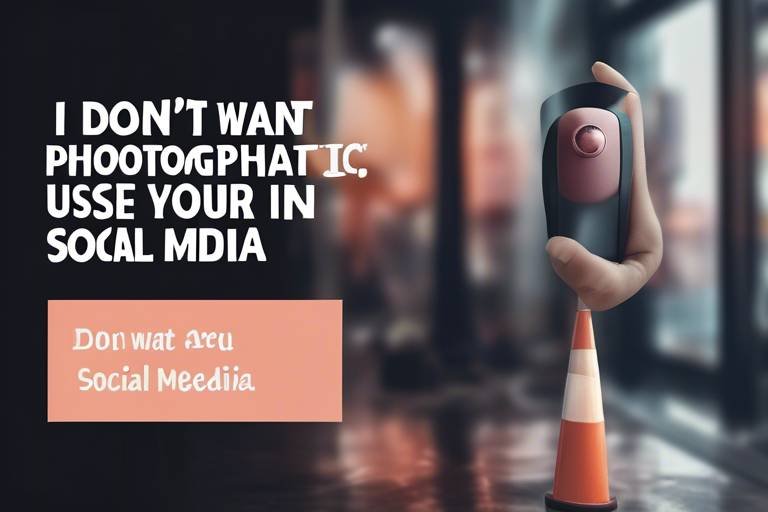The Dangers of Geotagging on Social Media
In today's digital age, where sharing moments has become second nature, geotagging on social media platforms presents a double-edged sword. While it allows us to connect with friends and showcase our adventures, it also opens the door to a myriad of risks that can compromise our safety and privacy. Imagine posting a picture of your vacation, complete with the exact location, only to find out later that someone used that information to track your movements. This article delves into the potential dangers associated with geotagging, including privacy concerns, stalking, and identity theft. Understanding these risks is crucial for anyone who enjoys sharing their life online, as it empowers users to make informed decisions about their digital presence.
Geotagging is the process of adding geographical identification metadata to various media, including photographs and social media posts. This technology is prevalent across platforms like Instagram, Facebook, and Twitter, allowing users to share their location with just a click. When you post a photo at a specific location, that geographical data is embedded in the image or post, making it accessible to anyone who views it. This feature can enhance social interactions, enabling friends to see where you are and what you're up to. However, this convenience comes at a cost, as it also makes it easier for others to track your whereabouts. Think of it as leaving a digital breadcrumb trail that anyone can follow.
The privacy risks associated with geotagging are significant and often overlooked. By sharing your location, you may inadvertently expose yourself to unwanted attention or even threats. For instance, imagine posting a photo at a café you frequent, complete with the location tagged. While this may seem harmless, it could alert someone with ill intentions about your regular habits. The reality is that not everyone who sees your posts has good intentions. The more information you share, the easier it is for someone to piece together your daily routine, leading to potential risks.
One of the most alarming consequences of geotagging is the increased risk of stalking and harassment. When individuals share their location publicly, they become vulnerable to those who may wish to harm them. There have been numerous real-life instances where people have faced danger due to their geotagged posts. For example, a woman shared her location while attending a concert, and later found herself being followed by someone who had seen her post. These situations highlight the importance of being cautious about what we share online. It's not just about sharing our lives; it's about protecting our privacy and safety.
To further illustrate the dangers of geotagging, let's consider a few case studies:
| Incident | Details | Outcome |
|---|---|---|
| Concert Stalking | A woman posted her location at a concert, leading to unwanted attention. | She was followed home and had to report the incident to authorities. |
| Vacation Break-in | A family shared their vacation location, resulting in a burglary at their home. | They returned to find their house ransacked. |
To protect yourself from stalking and harassment linked to geotagging, consider the following strategies:
- Adjust your privacy settings to limit who can see your posts.
- Disable geotagging features on your devices and social media accounts.
- Think twice before sharing your location, especially in real-time.
Geotagging can also facilitate identity theft, as criminals can exploit location data to target individuals. For instance, if someone knows you are on vacation, they may take advantage of your absence to break into your home. Furthermore, sharing location data can provide thieves with insights into your daily routines, making it easier for them to plan their attacks. It's essential to recognize that the more information you share, the more vulnerable you become. Protecting your identity should be a top priority, and being mindful of geotagging is a crucial step in that direction.
Social media platforms have established policies regarding geotagging, but their effectiveness in protecting users' privacy is often debated. While many platforms allow users to control their privacy settings, they also encourage sharing for engagement and visibility. This creates a conflict between user safety and platform growth. It's vital for users to be aware of these policies and take charge of their settings to safeguard their information.
Ultimately, users play a crucial role in their online safety. It's essential to manage your geotagging settings actively and remain aware of potential risks. Don't rely solely on social media platforms to protect you; take responsibility for your own safety by being cautious about what you share and who can see it. Remember, your digital footprint can have real-world consequences.
Educating users about the dangers of geotagging is essential in promoting safer online practices. Various initiatives and resources aim to raise awareness about the risks associated with sharing location data. By staying informed and proactive, users can better protect themselves from potential dangers. Consider attending workshops or reading articles on digital safety to enhance your understanding of these issues.
- What is geotagging? Geotagging is the process of adding geographical identification to media, such as photos and social media posts.
- How can geotagging affect my privacy? Sharing your location can expose you to unwanted attention and potential threats, including stalking and identity theft.
- What can I do to protect myself from the risks of geotagging? Adjust your privacy settings, disable geotagging features, and think carefully before sharing your location.
- Are social media platforms doing enough to protect users? While platforms have policies in place, it's ultimately the user's responsibility to manage their privacy settings and be aware of risks.

Understanding Geotagging
Geotagging is a fascinating yet often misunderstood feature that has become a staple in our digital lives. It involves the process of adding geographical identification to various forms of media, such as photographs, videos, and social media posts. Essentially, when you take a picture or share a status update, your device can automatically embed information about your location into the file. This data can include coordinates like latitude and longitude, or even a specific place name. It’s like leaving a breadcrumb trail of where you’ve been, and while this can enhance your online sharing experience, it also opens the door to a myriad of privacy concerns.
In today’s world, geotagging is prevalent across numerous social media platforms. From Instagram and Facebook to Snapchat and Twitter, users are encouraged to share their locations with friends and followers. This trend is driven by the desire for connection and the thrill of sharing experiences in real-time. But how does this work? When you enable location services on your device, it communicates with satellites to pinpoint your exact location. This information is then tagged to your content, making it easily accessible to anyone who views your post. While this can be fun and engaging, it’s crucial to understand the implications of sharing such sensitive information.
Consider this: when you share a photo from a bustling cafe in downtown, you’re not just showcasing your latte art; you’re also revealing your whereabouts to anyone who comes across your post. This can lead to unintended consequences, especially if your profile is public or if you have a large following. The thrill of sharing can quickly turn into a risk if one isn’t cautious about who has access to that information. With geotagging, you’re essentially giving away your location, and in some cases, your routine. This can create opportunities for unwanted attention, whether from curious acquaintances or more malicious actors.
To illustrate the prevalence of geotagging, let’s take a look at some statistics:
| Social Media Platform | Percentage of Users Who Geotag |
|---|---|
| 83% | |
| 72% | |
| 58% | |
| Snapchat | 65% |
As you can see, a significant percentage of users on these platforms engage in geotagging, which highlights the need for awareness regarding the potential risks involved. Understanding how geotagging works is the first step in ensuring your safety online. So, the next time you’re about to share that amazing sunset photo from your vacation, take a moment to consider whether everyone really needs to know exactly where you are. After all, in the digital age, a little caution can go a long way in protecting your privacy.

Privacy Risks
In today's digital age, geotagging has become a common practice among social media users. While it can be fun to share your location with friends and followers, it comes with significant privacy risks that are often overlooked. When you geotag a post, you're not just revealing where you are at that moment; you're also providing a breadcrumb trail of your movements. This seemingly harmless act can expose you to unwanted attention, potential stalkers, and even identity theft. Imagine walking down a street and announcing to the world exactly where you are. Sounds risky, right? That's exactly what geotagging does.
One of the primary concerns with geotagging is that it can make you an easy target for those with malicious intent. When someone knows your location, they can track your movements and predict your routine. This is particularly concerning for individuals who might be at risk of stalking or harassment. For example, if you frequently check-in at a specific location, a stalker could easily learn your habits and exploit that information. The very act of sharing your location can inadvertently invite danger into your life.
Moreover, sharing your location can lead to a loss of control over your personal information. Once you post something online, it's out there for anyone to see, and even if you delete it later, there's no guarantee it hasn't been captured or shared by someone else. This lack of control can be frightening, especially when you consider the various ways that criminals can use location data. For instance, they could use it to identify when you're not home, making your property a target for theft.
To illustrate the gravity of these risks, let's take a look at some alarming statistics:
| Risk Type | Percentage of Users Affected |
|---|---|
| Stalking | 30% |
| Identity Theft | 25% |
| Harassment | 20% |
As you can see, the risks are substantial and affect a significant portion of social media users. It's crucial to understand that while geotagging can enhance social interactions, it can also compromise your safety. The key is to weigh the benefits against the potential threats. Are those likes and comments worth the risk of being stalked or having your identity stolen? It's a tough question, but one that every user should consider before hitting that 'post' button.
In conclusion, the privacy risks associated with geotagging are real and should not be taken lightly. By being aware of these dangers and taking proactive steps to protect yourself, you can enjoy social media while minimizing your exposure to potential threats. Remember, your safety is more important than social validation!

Stalking and Harassment
In today's digital age, geotagging has become a common practice among social media users, allowing individuals to share their exact locations with friends and followers. While this feature can enhance our online interactions, it also opens the door to serious risks, particularly when it comes to stalking and harassment. Imagine posting a picture of your favorite café, complete with the location tag, only to find that someone has taken note of your whereabouts and is now following you. This scenario might sound extreme, but it’s a reality for many individuals who have unwittingly exposed their location online.
The risk of stalking and harassment is amplified by the ease with which geotagged information can be accessed. When users share their locations publicly, they may not realize that this information can be used by malicious actors to track their movements. For instance, if someone frequently posts their location at a gym or a local park, it can become a routine for a stalker to monitor their activities. Such behavior not only invades personal space but can escalate to more severe forms of harassment.
To illustrate the dangers, consider the following case studies:
- Case 1: A young woman shared her vacation photos on social media, geotagging each location. Upon returning home, she discovered that someone had been watching her posts and had broken into her house during her absence.
- Case 2: A college student frequently posted about her daily routines, including her commute to classes. She began receiving unwanted messages from someone who had been tracking her location through her posts, leading to a frightening encounter.
These examples highlight the potential for danger that comes with geotagging. The consequences can be severe, ranging from emotional distress to physical harm. Therefore, it’s crucial for users to understand the implications of their online behavior and take proactive measures to safeguard their privacy.
So, what can you do to protect yourself? Here are some preventative measures to consider:
- Always check your privacy settings on social media platforms to control who can see your posts and location.
- Consider disabling geotagging features on your device or within apps.
- Be cautious about sharing your location in real-time; instead, wait until you leave a location to post about it.
- Educate yourself on the signs of stalking and harassment, and don't hesitate to reach out for help if you feel unsafe.
In conclusion, while geotagging can enhance our social media experiences, it is essential to be aware of the potential dangers it poses. By understanding the risks of stalking and harassment associated with location sharing, users can take steps to protect themselves and maintain their safety in an increasingly interconnected world.
Q: What is geotagging?
A: Geotagging is the process of adding geographical identification metadata to various media, such as photos and social media posts, which allows users to share their exact locations.
Q: How can geotagging lead to stalking?
A: When individuals share their location publicly, it can be exploited by stalkers to monitor their activities and movements, potentially leading to harassment or worse.
Q: What are some ways to protect myself from geotagging risks?
A: You can protect yourself by adjusting your privacy settings, disabling geotagging features, and being mindful of when and what you share online.
Q: Should I stop using geotagging altogether?
A: Not necessarily. While it's important to be cautious, you can still enjoy sharing your experiences by being selective about what you share and with whom.

Case Studies
To truly grasp the potential dangers of geotagging, let’s delve into some real-life case studies that illustrate the risks involved. These examples not only highlight the consequences of careless sharing but also serve as cautionary tales for anyone who might underestimate the implications of their online footprint.
One notable case involved a young woman named Sarah, who frequently shared her location while out with friends. She posted a picture from a popular café, tagging her location and sharing it on multiple platforms. Within hours, she received a message from an individual she didn’t know, referencing her post and asking about her whereabouts. This unsettling experience escalated when the individual showed up at her favorite hangout spot the following week. Sarah’s story underscores the reality that geotagging can attract unwanted attention, leading to potential stalking or harassment.
Another alarming incident involved a family who shared their vacation photos on social media, geotagging each location they visited. While they were enjoying their time away, they were unaware that their home was left vulnerable. A thief monitored their posts and, realizing the family was away, broke into their house, stealing valuables and leaving them with a sense of violation. This case reveals how geotagging can inadvertently signal to criminals that a target is unprotected, turning a fun family trip into a nightmare.
Additionally, consider the case of a public figure, a popular influencer, who regularly shared her location during events. While her followers appreciated the updates, a stalker used this information to track her movements. It culminated in a frightening encounter where the stalker confronted her outside an event, leading to legal action and heightened security measures. This incident highlights the risks that come with a public persona, especially when geotagging is involved.
These case studies illustrate the profound impact that seemingly innocuous geotagging can have on individuals' lives. It’s not just about sharing where you are; it’s about understanding the potential consequences of that information falling into the wrong hands. In each of these scenarios, the victims faced significant emotional distress and, in some cases, physical danger due to their online sharing habits. Therefore, it’s crucial to approach geotagging with caution and awareness.
In light of these examples, it's evident that geotagging can lead to serious privacy breaches and safety concerns. To mitigate these risks, users should adopt proactive measures, such as adjusting privacy settings and being mindful of what they share online. Remember, once something is posted, it can be difficult to take back, and the consequences may be more severe than you anticipate.

Preventative Measures
In a world where sharing is the norm and social media is an integral part of our lives, it’s crucial to understand how to protect ourselves from the potential dangers of geotagging. While geotagging can enhance our social sharing experience, it can also open the door to unwanted attention and threats. So, what can you do to safeguard your privacy? Here are some effective strategies.
First and foremost, disabling geotagging features on your devices can significantly reduce the risk of exposing your location. Most smartphones and social media apps have settings that allow you to turn off location services. By doing this, you can enjoy sharing your experiences without revealing your exact whereabouts. Remember, just because the option is there doesn’t mean you have to use it!
Another vital step is to review your privacy settings on social media platforms. Each platform has different privacy controls that allow you to manage who can see your posts and whether they can view your location data. Take the time to familiarize yourself with these settings and adjust them according to your comfort level. For instance, consider limiting your audience to friends only, instead of making your posts public.
Additionally, it’s essential to think before you post. Before sharing a photo or status update, ask yourself: “Is this information safe to share?” If you’re at a public event or on vacation, it might be best to wait until you’re back home to share those details. This simple pause can protect you from potential stalking or harassment.
Moreover, educating yourself about the risks associated with geotagging can empower you to make informed decisions. Stay updated on the latest trends in online safety and privacy. Resources like online workshops, webinars, or articles can provide valuable insights into how to navigate the digital landscape securely.
Lastly, consider sharing your knowledge with friends and family. By discussing the dangers of geotagging and the importance of privacy, you can create a community of informed users who look out for one another. Remember, safety in numbers is not just a saying; it’s a principle that applies to online interactions as well.
By implementing these preventative measures, you can enjoy the benefits of social media while minimizing the risks associated with geotagging. Remember, your safety is in your hands, and a little caution can go a long way in protecting your personal information.
- What is geotagging? Geotagging is the process of adding geographical identification to media, such as photos and posts, which can reveal your location.
- How can I disable geotagging on my device? You can disable geotagging in the settings of your smartphone or social media apps by turning off location services.
- Why is it important to manage privacy settings? Managing your privacy settings helps control who can see your posts and protects your location data from being publicly accessible.
- What should I do if I feel threatened due to geotagging? If you feel threatened, it’s crucial to report the situation to the authorities and consider adjusting your privacy settings immediately.

Identity Theft
In today's digital age, the concept of identity theft has evolved into a pressing concern, especially with the advent of geotagging on social media platforms. When users share their location through photos or posts, they might be unknowingly providing a treasure trove of information for cybercriminals. Imagine this: you post a picture of your vacation, proudly displaying your sunny beach destination. While your friends are admiring your getaway, a malicious actor could be tracking your movements, figuring out when you are away from home, and planning their next move. This is where the dangers of geotagging become alarmingly clear.
Criminals can exploit geotagged data to piece together a detailed profile of an individual, including their daily routines, favorite hangout spots, and even their home address. This information can be used to commit various forms of identity theft, such as:
- Account Takeover: By knowing where you frequently check in, thieves can guess passwords or security questions related to your location.
- Physical Burglary: If a criminal knows you're on vacation, they may target your home for theft, believing it to be unoccupied.
- Social Engineering: With enough information, scammers can impersonate you, leading to fraudulent activities that could damage your reputation and finances.
It's crucial to understand that identity theft can happen to anyone, regardless of their social media savvy. The more information you share, the easier it becomes for someone to take advantage of it. For instance, a seemingly innocent post about a night out could reveal your favorite bar, which may lead someone to track your movements. In fact, many identity theft cases begin with seemingly harmless online behavior. A recent report indicated that over 30% of identity theft cases involved social media platforms where users had geotagged their locations. This statistic serves as a stark reminder of the potential risks associated with sharing location data.
To combat these risks, it is essential for individuals to take proactive measures to safeguard their personal information. Here are a few strategies to consider:
- Adjust Privacy Settings: Regularly review and update your social media privacy settings to control who can see your posts and location data.
- Think Before You Post: Always consider the potential consequences of sharing your location. Ask yourself if the post is worth the risk.
- Limit Geotagging: Disable geotagging features on your devices or choose to share your location only with trusted friends.
Ultimately, the key to preventing identity theft lies in awareness and caution. By understanding the implications of geotagging and taking steps to protect your personal information, you can significantly reduce the risk of falling victim to identity theft. Remember, in a world where information is power, safeguarding your identity is the first line of defense against those who seek to exploit it.
- What is geotagging? Geotagging is the process of adding geographical identification to media, such as photos and social media posts, indicating where they were taken.
- How can geotagging lead to identity theft? By sharing your location, you provide potential thieves with information about your whereabouts, routines, and personal life, making it easier for them to target you.
- What can I do to protect myself from identity theft? Adjust your privacy settings, think before posting location data, and limit geotagging to trusted individuals to enhance your safety.
- Are there any tools to help manage geotagging? Yes, many social media platforms offer privacy tools that allow users to manage their geotagging settings effectively.

Social Media Policies
In today’s digital landscape, social media platforms have become a double-edged sword. While they offer incredible opportunities for connection and sharing, they also come with significant risks, particularly concerning geotagging. Each platform has its own set of policies designed to manage the use of geotagging, but how effective are these measures in safeguarding user privacy? Let’s delve into the policies of some of the most popular social media platforms and assess their effectiveness.
Most major social media platforms, such as Facebook, Instagram, and Twitter, provide users with the option to enable or disable geotagging features. This means that when you share a photo or a post, you can choose whether or not to include your location. However, the default settings often have geotagging enabled, which can lead to unintended consequences if users are not aware of their settings. It’s crucial for users to understand that even when they disable geotagging, the platform may still collect location data for various purposes, such as targeted advertising.
To illustrate how these policies vary, here’s a brief overview of geotagging features across some popular platforms:
| Platform | Geotagging Options | Privacy Settings |
|---|---|---|
| Enable/Disable Location Tagging | Customizable privacy settings for posts | |
| Location Tagging for Posts and Stories | Account privacy settings (Public/Private) | |
| Location Information on Tweets | Control over who sees your tweets |
While these platforms do provide users with some control over their geotagging settings, the responsibility ultimately falls on the user to manage these settings effectively. Many users may not realize the implications of sharing their location, especially when posting in real-time. This lack of awareness can lead to dangerous situations, such as stalking or harassment, as previously discussed.
Moreover, social media companies often include disclaimers in their terms of service that users might overlook. These disclaimers typically outline how location data is used, stored, and shared. For instance, data might be used to enhance user experience through personalized content or advertising, but it can also be accessed by third parties in certain situations. This raises important questions about the transparency of these policies and whether users truly understand what they are consenting to when they click “Accept” on these terms.
In light of these challenges, it's essential for users to take an active role in managing their privacy. This means regularly reviewing their geotagging settings and being mindful of what they share online. By doing so, users can significantly reduce their risk of falling victim to privacy breaches or malicious activities.
Furthermore, social media companies must also step up their game by enhancing user education regarding geotagging. This could involve more prominent notifications about the risks associated with location sharing, as well as providing clearer instructions on how to adjust privacy settings. After all, an informed user is a safer user.
In conclusion, while social media policies regarding geotagging do exist, their effectiveness largely depends on user awareness and engagement. It’s a partnership between the platforms and the users to ensure that sharing remains safe and enjoyable. As we navigate this digital age, let’s be vigilant and proactive about our online presence, ensuring that we protect ourselves from the potential dangers lurking in the shadows of geotagging.
- What is geotagging? Geotagging is the process of adding geographical identification to media, such as photos and posts, which can reveal the location where the content was created.
- How can I disable geotagging on my social media accounts? You can usually find geotagging options in your account settings under privacy or location settings. Make sure to review these settings regularly.
- Are there risks associated with geotagging? Yes, geotagging can expose users to privacy risks, including stalking, harassment, and identity theft.
- What can I do to protect my privacy on social media? Regularly update your privacy settings, be mindful of what you share, and consider disabling geotagging features when posting.

User Responsibility
When it comes to geotagging, the responsibility lies heavily on the shoulders of the users. In this digital age, where sharing is as easy as a tap on your smartphone, it’s crucial to understand that every photo or post can reveal more than just a moment in time; it can expose your location and, consequently, your safety. It’s like leaving your front door wide open while you’re away—inviting danger without even realizing it. So, what can you do to safeguard your privacy?
First and foremost, users must take an active role in managing their geotagging settings across various social media platforms. Most platforms provide options to turn off location sharing or to limit it to certain posts. For instance, if you’re at a concert or on vacation, consider whether it’s necessary to share your exact location in real-time. Posting a photo after the fact can still capture the memory without broadcasting your whereabouts to the world. Being mindful of when and what you share is a powerful tool in protecting yourself.
Moreover, users should regularly review their privacy settings. Social media platforms often update their policies and settings, which may inadvertently change your privacy status. By taking the time to familiarize yourself with these settings, you can ensure that you’re not unintentionally providing more information than you intend. Remember, it’s not just about what you post; it’s about who can see it. Here are a few tips to consider:
- Check your privacy settings: Make sure you know who can see your posts and whether location data is included.
- Limit geotagging: Turn off geotagging for photos and posts unless absolutely necessary.
- Think before you share: Consider the potential consequences of sharing your location in real-time.
Additionally, it’s essential to educate yourself and others about the risks associated with geotagging. Many users may not realize the dangers lurking behind their seemingly innocent posts. By discussing these risks with friends and family, you can foster a culture of awareness and caution. Sharing informative articles, hosting discussions, or even creating social media campaigns can amplify the message of safety in digital sharing.
Ultimately, while social media platforms have a role in protecting users, the most effective safeguard is a well-informed user. By taking responsibility for your online presence, you not only protect yourself but also contribute to a safer online community. Remember, the digital world mirrors the real world—just as you wouldn’t shout your home address to a crowd, think twice before broadcasting your location online!

Educating Users
In today's digital age, where sharing moments through social media is as common as breathing, educating users about the dangers of geotagging is more crucial than ever. Many individuals are blissfully unaware of the potential risks associated with tagging their locations in posts or photos. It's like leaving your front door wide open while you go on vacation—inviting trouble without even realizing it! So, how can we empower users to make safer choices when it comes to geotagging?
First and foremost, awareness is key. Users need to understand what geotagging is and how it works. Geotagging involves embedding location data into photos or posts, which can be easily accessed by anyone who views that content. This seemingly harmless feature can quickly turn into a double-edged sword. To combat this, social media platforms should provide clear and accessible information about the implications of geotagging. A simple pop-up message when a user attempts to tag their location could serve as a gentle reminder of the potential risks involved.
Moreover, educational initiatives should focus on teaching users how to adjust their privacy settings. Many people may not even realize that their location settings are enabled by default. By providing step-by-step guides on how to disable geotagging or manage privacy settings, users can take control of their online presence. For instance, a table could be created to summarize the privacy settings available on popular social media platforms:
| Social Media Platform | Geotagging Settings | Link to Instructions |
|---|---|---|
| Manage Location Settings | Link | |
| Disable Location Tagging | Link | |
| Turn off Location Services | Link |
Additionally, community workshops and online webinars can be organized to discuss the importance of online safety and privacy. These sessions could feature experts in cybersecurity who can share real-life stories and statistics that highlight the dangers of geotagging. Just imagine the impact of hearing a personal account from someone who experienced stalking or identity theft due to oversharing their location!
Furthermore, social media influencers and content creators hold significant power in shaping user behavior. By promoting the message of responsible sharing and educating their followers about the risks of geotagging, they can foster a culture of safety. Perhaps they could create engaging content, such as videos or infographics, that simplify the complexities of privacy settings while emphasizing the importance of protecting personal information.
Ultimately, the goal is to create a community of informed users who understand the implications of their online actions. By making education accessible and engaging, we can help individuals navigate the digital landscape with confidence and caution. Remember, a little knowledge goes a long way in ensuring that your online experience is not only enjoyable but also safe!
- What is geotagging? Geotagging is the process of adding geographical identification to media, such as photos and posts, which can reveal your location.
- How can I disable geotagging on my social media accounts? You can disable geotagging by adjusting your privacy settings on each platform. Refer to the provided links in the table for specific instructions.
- Why is geotagging a privacy concern? Geotagging can expose your location to anyone who views your posts, potentially leading to unwanted attention, stalking, or identity theft.
- What should I do if I’ve shared my location publicly? If you've shared your location publicly and feel unsafe, consider removing the post and reviewing your privacy settings to limit future exposure.
Frequently Asked Questions
- What is geotagging and how does it work?
Geotagging is the process of adding geographical identification to various media, like photos and social media posts. It typically includes latitude and longitude coordinates that pinpoint where the content was created. This feature is widely used on platforms like Instagram and Facebook, allowing users to share not just what they’re doing, but where they are doing it.
- What are the privacy risks associated with geotagging?
Geotagging can expose users to significant privacy risks. When you share your location, you might inadvertently invite unwanted attention, harassment, or even stalking. For example, if someone knows your favorite hangout spots, they could track your movements and potentially put you in danger.
- How can geotagging lead to stalking or harassment?
By publicly sharing your location, you make it easier for individuals with malicious intent to find you. There have been numerous real-life cases where people were stalked or harassed after sharing their locations online. This highlights the importance of keeping your geotagging settings private or turning them off entirely.
- What preventative measures can I take against stalking linked to geotagging?
To protect yourself, consider adjusting your social media privacy settings to limit who can see your posts. Avoid sharing your location in real-time and think twice before posting about your whereabouts. Additionally, regularly review your friend list and remove anyone you don't trust.
- Can geotagging facilitate identity theft?
Yes, geotagging can make it easier for identity thieves to target individuals. By knowing where you are, criminals can exploit this information to steal your identity, especially if they can piece together other personal details from your social media profiles.
- What should I know about social media policies on geotagging?
Social media platforms have varying policies regarding geotagging, but they often focus on user privacy and safety. It's crucial to familiarize yourself with these policies and understand how to manage your geotagging settings to ensure your safety online.
- What is my responsibility as a user regarding geotagging?
As a user, it's your responsibility to be aware of the potential risks associated with geotagging. You should regularly check and adjust your privacy settings, be cautious about what you share, and educate yourself on how to stay safe online.
- How can I educate myself about the dangers of geotagging?
There are many resources available online, including articles, videos, and workshops that focus on online safety and privacy. Engaging with these resources can help you understand the risks of geotagging and how to protect yourself effectively.



















